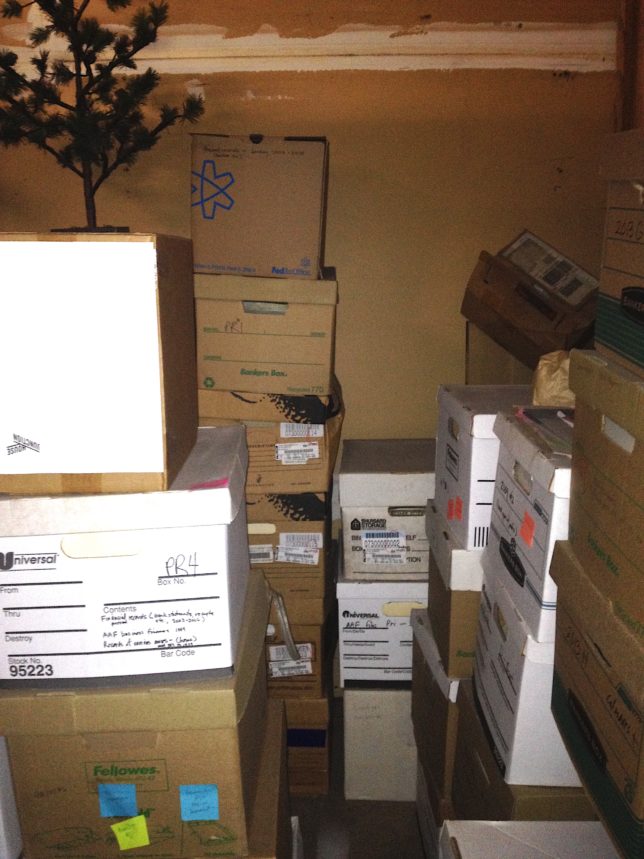Anne Focke Archive Collection
“When does history begin?”
This is a question student interns and I talked a lot about when we started digging through boxes of files from Arts Wire, an early online network I started and led from 1989 to about 1996. At a certain point, as they went through the files, the interns began to realize they were reading history. As one of them said, “This is history, and you’re still alive!” As history, it was related to their art history studies, but it was also closely connected and directly relevant to current events, which was especially clear when they read about the political turmoil of the late ’80s and early ’90s culture wars.
At the time, I was Alum in Residence at the University of Washington’s School of Art + Art History + Design, and the students were helping me begin to inventory all the boxes of documents and ephemera I’d accumulated over the decades. They only made it through a few of the boxes because, rather than making a simple inventory, they started reading it all. That’s when the “history” came alive. By the end of the year, they’d created two exhibitions about what they’d found, produced a 14-episode podcast for which they interviewed people from around the country whom they’d discovered in the files, and each wrote a paper about their experience.
Last summer, I was fortunate to have made a connection with Anna Hurwitz, a graduate student in the UW Masters of Library and Information Science program. With her help, I was host site supervisor for her Directed Fieldwork in the fall, 2017. She used my collection of files to gain experience creating inventories and a finding aid for a small archive. She began the process of inventorying my material, box by box, folder by folder. A website documenting her DFW work. including the deliverables, can be found here.
[more to come]
This is a site in progress, and it will probably continue to change over time. It contains inventories of files I’ve accumulated over the decades. It primarily includes documents and ephemera related to the work I’ve done, though it also includes some personal files because I’ve never been very good at separating the two.
To get a sense of the contents of the entire collection, you can see the “About me” section on this site for information about the work I’ve done over the decades.
INVENTORIES
Master Inventory
An Excel file with a spreadsheet for each of about eight series of boxes. Each series includes a numbered record for each box in the series. The names of the series are often based on when I moved boxes to storage. I tended to move quite a few at once, and always made a list of what I moved, usually with a few annotations. Sometimes I’d add a couple of boxes to the same list a little later, and at other times I’d create a new list. I wasn’t especially consistent, but at least I kept lists.
073 Series
This series includes the first boxes I started moving into storage in about 1989. I used a storage company that didn’t rent individual units but that used an inventory system allowing the company to retrieve your boxes (or whatever) when you wanted them. Everything I stored was given a number that began with 07300, followed by three digits that identified each of my specific boxes. The contents in the boxes go back to about 1979.
IW Series
This series contains records of my Independent Work as a freelancer from about 1984 when and/or closed until 1997, when the “Alpha Series” starts and I started working for GIA ( full-time in 1998). Arts Wire, which happened during this time, has its own series.
Arts Wire Series
Files in this series go from 1989-1996. When I made my exit from Arts Wire in 1995 or 1996, I put all the files I’d collected in storage. I didn’t ship them across the country to the New York Foundation for the Arts, who didn’t want them anyway especially since they already had their own files.
Alpha Series 1997-2006
When GIA got its first office, I brought my “alpha files” with me. “Alpha” because things were filed alphabetically rather than by project – individuals, events, or groups, often with just one folder. It was handy to have these “non-GIA” files there because, throughout my life, so many people and activities have overlapped from one project to another and from my personal to my working life. While at GIA, I hired Nason to create an inventory of these files for me. This series has had other names (“AAF Inventory,” the “AAF GIA series,” the “aaf files fm gia, 10-06,” and the “GIA series.”).
2009, 2013 Series
Archives Series
2016 Series
PR series. (personal records)

